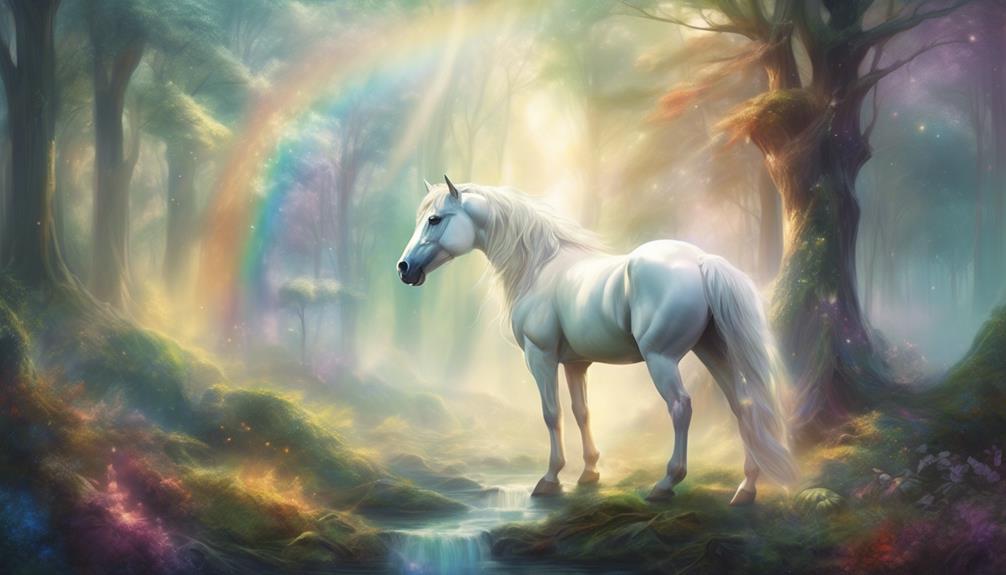Unicorns have long been associated with mythology and folklore, but recent scientific discoveries have shed new light on their existence. Did you know that a real-life species resembling the mythical unicorn roamed the Earth thousands of years ago?
Contrary to popular belief, this creature bore a closer resemblance to a giant, hairy rhinoceros rather than the elegant horse often depicted in stories and art. The discovery of a remarkably well-preserved skull has sparked a renewed interest in uncovering the truth about these majestic creatures and their place in natural history.
Mythical Origins of Unicorns
The mythical origins of unicorns can be traced back to ancient civilizations and folklore, where they were revered as symbols of purity, magic, and beauty across various cultures.
However, recent scientific discoveries have shed new light on the existence of the Siberian unicorn. Fossils of the Siberian unicorn, Elasmotherium sibiricum, have been found in Kazakhstan, challenging previous beliefs that the species went extinct 350,000 years ago.
The discovery of a 29,000-year-old Siberian unicorn skull has shifted our understanding of the timeline of unicorn existence. Contrary to popular depictions, unicorns bore a striking resemblance to modern-day rhinos, standing at 6 feet 6 inches tall, over 15 feet long, and weighing more than 4 tons.
These findings have added a new layer of significance to the mythical creature and its cultural impact.
Historical Accounts and Folklore
Historical accounts and folklore depict unicorns as symbols of purity, magic, and beauty across various cultures, perpetuating their mythical significance throughout human history.
The recent discovery of the Siberian unicorn challenges traditional perceptions. Contrary to the popular horse-like depiction, this creature resembled a giant, hairy rhinoceros. Fossils found in the Pavlodar region of Kazakhstan, dating back approximately 29,000 years ago, have reshaped our understanding of the unicorn's existence.
Research from Tomsk State University, published in the American Journal of Applied, debunked the belief that the species went extinct 350,000 years ago, altering the timeline significantly.
As a result, the real-life discovery of unicorns adds a new layer to their cultural significance and sparks curiosity and fascination worldwide, prompting a reevaluation of historical accounts and folklore.
Modern Sightings and Evidence
Challenging traditional perceptions of unicorns as horse-like creatures, modern sightings and evidence suggest that the Siberian unicorn (Elasmotherium sibiricum) resembled a giant, hairy rhinoceros instead. Researchers at Tomsk State University found a Siberian unicorn skull in Kazakhstan, dating it to around 29,000 years ago, altering the understanding of unicorn extinction.
These creatures stood six-and-a-half feet tall and weighed four tons. They were primarily found in the south of Western Siberia. The fossilized skull discovery altered the timeline of unicorn extinction and provided insights into their physical characteristics. Unicorns looked more like rhinos or pint-sized, one-horned woolly mammoths, challenging the traditional image popularized in fairy tales and myth.
This discovery adds a new layer to the cultural significance and fascination surrounding these mythical creatures, sparking curiosity and challenging long-held perceptions.
Scientific Theories and Speculations
Scientific research and analysis have led to compelling evidence challenging traditional perceptions of unicorns as horse-like creatures, shedding light on their true physical characteristics and evolutionary timeline.
Recent discoveries, such as the dating of a Siberian unicorn skull to around 29,000 years ago, have reshaped our understanding of these mythical creatures. This challenges the previous belief that the species went extinct 350,000 years ago.
Unicorns, more closely resembling giant, hairy rhinos, stood about 6 feet 6 inches tall, measured around 15 feet long, and weighed around 8,000 pounds. These findings have significant implications for our understanding of unicorns and highlight the difference between myth and reality.
The scientific community continues to explore and unravel the mysteries surrounding unicorns, offering a more accurate portrayal that differs from the popular depictions seen in TV shows and folklore.
Uncovering the Truth About Unicorns
The recent discoveries regarding the physical characteristics and evolutionary timeline of unicorns have led to a compelling shift in our understanding of these mythical creatures, particularly in terms of their resemblance to giant, hairy rhinos.
The Siberian unicorn, Elasmotherium sibiricum, stood at a remarkable 6 ½ feet long and weighed a colossal four tons, making it the longest in comparison with the rest of the rhinoceros family. Recent findings challenge the traditional image of unicorns and suggest that they looked more like rhinos or pint-sized, one-horned woolly mammoths.
Researchers believe that the unicorn's diet primarily consisted of grass. These discoveries not only shed light on the true nature of unicorns but also add a new layer to their cultural significance, given their longstanding presence in human mythology and folklore.
Frequently Asked Questions
Is There Real Unicorns in the World?
Scientific evidence supports the existence of mythical creatures in folklore tales. Historical sightings and modern sightings have contributed to the symbolic meaning and cultural significance of unicorns. However, no real unicorns exist in the world.
Where Are Unicorns Found?
Unicorn sightings have been a part of ancient legends and folklore tales, with historical evidence dating back to ancient Greek natural history writings. Their symbolism as mythical creatures continues to inspire modern depictions.
Do Unicorns Used to Be Alive?
Scientists have found fossil evidence of horned animals resembling unicorns, challenging historical depictions. They believe genetic mutations and ancient artwork may have influenced the mythological origins of fairy tale creatures, sparking curiosity and fascination.
Is Unicorn Real or Myth?
Historical evidence and scientific research have brought about new understandings of mythical creatures. Their symbolic meanings in folklore tales and modern interpretations have sparked cultural significance, challenging previous beliefs and adding layers of fascination.

